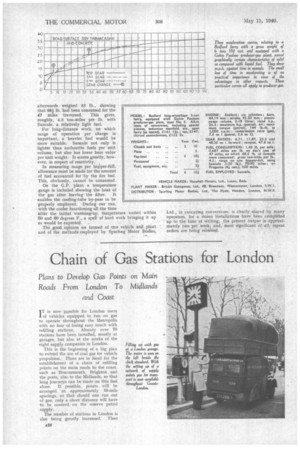Chain of Gas Stations for London
Page 28

Page 31

If you've noticed an error in this article please click here to report it so we can fix it.
Plans to Develop Gas Points on Main Roads From London To Midlands and Coast iT is now passible for London users of vehicles equipped to run on gas to operate throughout the Metropolis with no fear of losing easy touch with refilling stations. Already over 70 stations have been installed, mostly at garages, but ahlo at the works of the eight supply companies in London.
This is the beginning of a big plan to extend the use of coal gas for vehicle propulsion. Plans are in hand for the establishment of a chain of refilling points on the main roads to the coast, such as Bournemouth, Brighton . and the ports, also to the Midlands, so that long journeys can be made on this fuel alone. If possible, points will be arranged at approximately 10-mile spacings, so that should one run out of gas, only a short distance will have to be covered on the reserve petrol supply.
The number of stations in London is also being greatly increased. Fleet owners can have standpipes installed. The cost would be approximately £14£20, and the hire of a meter works out at £1 per quarter. Standardization of the standpipe delivery outfit and the gas-bag intake has been established.
We are informed also the London Gas Development Association that prices have been agreed upon which make the cost of running on gas approximately equal to that of running on petrol, when the supply is taken from a garage. The garage owner is charged Itcl, per therm or whatever the local cost may be which is the price paid by the vehicle owner. Ile, however, will have to pay a filling charge, which is an agreed amount ranging from 4d. for a gasbag up to 125 cubic ft., 5d. for 125-200 cubic ft., ad. 200-250 cubic ft., and so on per fill of gas.
The Distance Factor The distance that can be covered per
fill is up to 20 miles. It so happens that this iS the same regardless of the size of the 'vehicle, the bigger the vehicle the" bigger the bag and the bigger the Consumption. 7 This, of course, shows one of the disadvantages of gas-the need for frequent replenishment. •
Filling time varies with the size of the bag, but would take roughly ten minutes for a 200-cubic-ft. bag.
Gas for transport purposes is virtually unrationed. Indeed, the Ministry of Mines is encouraging such conversions, and we are given to understand that, although-there was a threat to restrict the normal consumption at the outbreak of war, there had. been no intention seriously to restrict its use for vehicle propulsion. Consequently, when running on gas one has almost unlimited mileage possibilities.
Gas is regarded as a valuable wartime substitute for pettoI, but it is frankly admitted that with the present type of engine it cannot hope to obtain as a peace-time fuel. There is a loss of power and a drop in maximum speed, but on the credit side there is the retention of smooth-running characteristics and a freedom from carbon formation and oil dilution. Starting from cold is also very easy.
Conversion a Simple Matter
The conversion of a vehicle to run on gas is simple. A special carburetter is placed beside the petrol instrument and the bag is fitted to the top of the vehicle or carried on a low-built trailer. The two fuels are interchangeable; one can switch from gas on to petrol or vice versa, as one pleases.
Modern gas bags are well made and substantial and much care has been devoted to securing them against wind resistance.
A list of garages at which standpipes have been -installed is given on this page, whilst many companies are now in a position to undertake conversions. A number of these is also listed.
The fact that so many refuelling points are now available makes gas propulsion more practicable, and with the development of further stations a bigger demand for gas is to be expected. Conversions cost froni about upwards.




























































